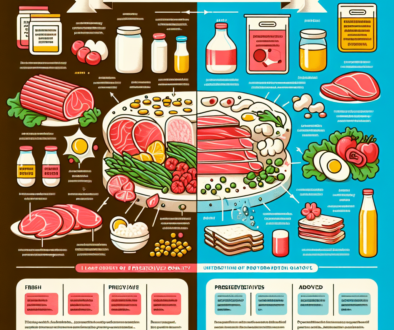Sensory Evaluation Methodologies for Proteins: Tasting the Difference
-
Table of Contents
- Sensory Evaluation Methodologies for Proteins: Tasting the Difference
- Understanding Sensory Evaluation
- Key Sensory Evaluation Techniques for Protein Products
- Descriptive Analysis in Detail
- Discrimination Testing and Its Importance
- Consumer Testing for Market Success
- Statistical Analysis in Sensory Evaluation
- Case Studies and Examples
- Challenges and Future Directions
- Conclusion: The Role of Sensory Evaluation in Protein Product Development
- Discover ETprotein’s High-Quality Protein Products
Sensory Evaluation Methodologies for Proteins: Tasting the Difference

Proteins are essential macronutrients in our diet, playing a critical role in building, maintaining, and repairing tissues. With the rise of alternative protein sources, such as plant-based proteins, the food industry has seen a surge in the need for sensory evaluation methodologies to ensure these new products meet consumer expectations in terms of taste, texture, and overall acceptability. This article delves into the various sensory evaluation techniques used to assess the quality of protein products and how they help manufacturers refine their offerings to appeal to a broad market.
Understanding Sensory Evaluation
Sensory evaluation is a scientific discipline that applies principles of experimental design and statistical analysis to the use of human senses (sight, smell, taste, touch, and hearing) for the purpose of evaluating consumer products. The goal is to gather insights on how products are perceived by the senses, which can be critical for product development and quality control.
Key Sensory Evaluation Techniques for Protein Products
Several methodologies are employed to assess the sensory attributes of protein products. These can be broadly categorized into analytical and affective tests:
- Descriptive Analysis: This method involves trained panelists who describe and quantify specific sensory attributes of a product. For proteins, attributes such as flavor, aftertaste, texture, and mouthfeel are critically assessed.
- Discrimination Testing: These tests determine whether there are detectable differences between products. They are often used in quality control to ensure consistency in protein products from batch to batch.
- Consumer Testing: Affective tests involve potential consumers and are used to determine the acceptability of a product or to compare the preferences for multiple products. This method is crucial for market-oriented product development.
Descriptive Analysis in Detail
Descriptive analysis is one of the most comprehensive sensory evaluation techniques. It provides a detailed profile of a product’s sensory characteristics. For protein products, this might include:
- Flavor notes such as earthy, nutty, or beany
- Texture aspects like grittiness, creaminess, or chewiness
- Appearance factors such as color and consistency
Case studies have shown that descriptive analysis can help manufacturers understand how different protein sources or processing methods affect the sensory profile of their products, leading to targeted improvements.
Discrimination Testing and Its Importance
Discrimination tests, such as triangle tests, duo-trio tests, and paired comparison tests, are essential for ensuring product consistency. For example, if a manufacturer changes the source of their protein, they can use discrimination testing to determine if the change is detectable and whether it affects consumer perception.
Consumer Testing for Market Success
Consumer testing often involves hedonic scales where participants rate their liking or disliking of a product’s attributes. This feedback is invaluable for product development, as it directly reflects potential market acceptance. For proteins, this might involve tasting sessions with different demographic groups to understand preferences across different market segments.
Statistical Analysis in Sensory Evaluation
Statistical analysis is a cornerstone of sensory evaluation, ensuring that the results are scientifically valid and reliable. Techniques such as Analysis of Variance (ANOVA), Principal Component Analysis (PCA), and Cluster Analysis are used to interpret sensory data and guide product development decisions.
Case Studies and Examples
Several studies have highlighted the importance of sensory evaluation in the protein industry. For instance, research on plant-based meat alternatives has shown that sensory attributes can be significantly improved by adjusting ingredients and processing techniques, leading to products that better mimic the taste and texture of animal meat.
Challenges and Future Directions
One of the challenges in sensory evaluation of proteins is the variability in individual perception. Future research is focusing on personalized nutrition and how genetic differences affect taste perception. Additionally, the rise of in-vitro tasting technologies, such as electronic tongues, offers new opportunities for non-subjective analysis of taste components.
Conclusion: The Role of Sensory Evaluation in Protein Product Development
Sensory evaluation methodologies are vital tools for the protein industry. They enable manufacturers to create products that not only meet nutritional requirements but also satisfy consumer demands for taste and texture. By employing a combination of descriptive analysis, discrimination testing, and consumer testing, along with robust statistical analysis, companies can ensure their protein products are both high-quality and market-ready.
Discover ETprotein’s High-Quality Protein Products
If you’re in the market for superior protein products, ETprotein is your go-to source. Their extensive range of organic and plant-based proteins is designed to meet the diverse needs of industries and consumers alike. With a focus on neutral taste and non-GMO, allergen-free attributes, ETprotein’s offerings are sure to satisfy your protein requirements.
About ETprotein:
ETprotein, a reputable protein Chinese factory manufacturer and supplier, is renowned for producing, stocking, exporting, and delivering the highest quality organic bulk vegan protein and plant proteins. They include Organic rice protein, clear rice protein, pea protein, clear pea protein, pumpkin seed protein, sunflower seed protein, mung bean protein, peanut protein etc. Their offerings, characterized by a neutral taste, non-GMO, allergen-free attributes, cater to a diverse range of industries. They serve nutraceutical, pharmaceutical, cosmeceutical, veterinary, as well as food and beverage finished product distributors, traders, and manufacturers across Europe, USA, Canada, Australia, Thailand, Japan, Korea, Brazil, and Chile, among others.
ETprotein specialization includes exporting and delivering tailor-made protein powder and finished nutritional supplements. Their extensive product range covers sectors like Food and Beverage, Sports Nutrition, Weight Management, Dietary Supplements, Health and Wellness Products, and Infant Formula, ensuring comprehensive solutions to meet all your protein needs.
As a trusted company by leading global food and beverage brands and Fortune 500 companies, ETprotein reinforces China’s reputation in the global arena. For more information or to sample their products, please contact them and email sales(at)ETprotein.com today.












